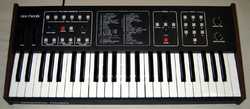Engineering:Sequential Circuits Six-Trak
| Six-Trak | |
|---|---|
 Sequential Circuits Six-Trak | |
| Manufacturer | Sequential Circuits |
| Dates | 1984 |
| Technical specifications | |
| Polyphony | 6 |
| Oscillator | 6 VCO |
| Synthesis type | Analog Subtractive |
| Input/output | |
| Keyboard | 49-key |
| Left-hand control | Pitch, Modulation |
| External control | MIDI |
The Six-Trak was an analogue synthesizer manufactured by Sequential Circuits in San Jose, California and released in January 1984. It is notable for being one of the first multi-timbral synthesizers, equipped with MIDI and an on-board six-track digital sequencer, hence the name. It was designed as an inexpensive and easily portable 'scratch-pad' machine for trying out arrangements. You can latch the arpeggiator and play along with sequences in real time. Also available is a unison mode which renders the keyboard monophonic but allows for very rich sounding timbres.
The Six-Trak is prominently featured and can be heard on the 1998 minimalist space music CD release The Dream Garden, by musician/composer Dane Rochelle. More recently it has been used by composer Christopher de Groot for the 2012 soundtrack to Australian feature film "Sororal".
The Six-Trak's more famous sibling is the Prophet 5, widely used in much of the 1970s progressive rock. A number of other synthesizers made by Sequential Circuits used similar electronics, including the Multi-Trak, Max, and Split-8. the important parts on board of them was CEM3394 (a complete monophonic analog synth chip manufactured by Curtis Electromusic Specialties ). The Six-Trak used 6 chips for 6 voices of different timbre program.
Notable Users
- Gui Boratto
- Cirrus
- Helios Creed
- Überzone
- Solitaire (musician)
- Ruki Vverh!
- Chromeo
- Chris Tabron / The Ten Paces
- Luis Delgado
- Mitch Margo

